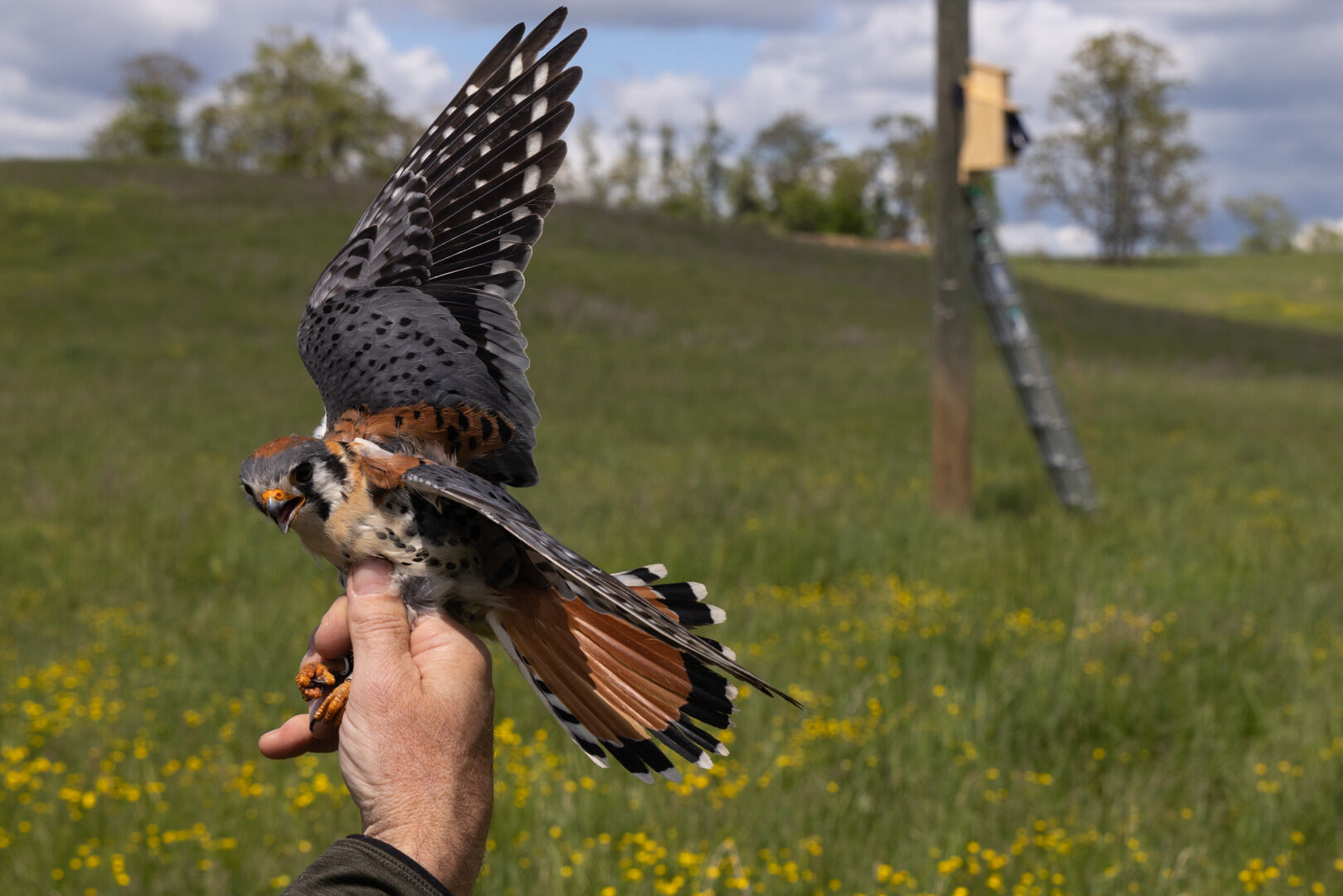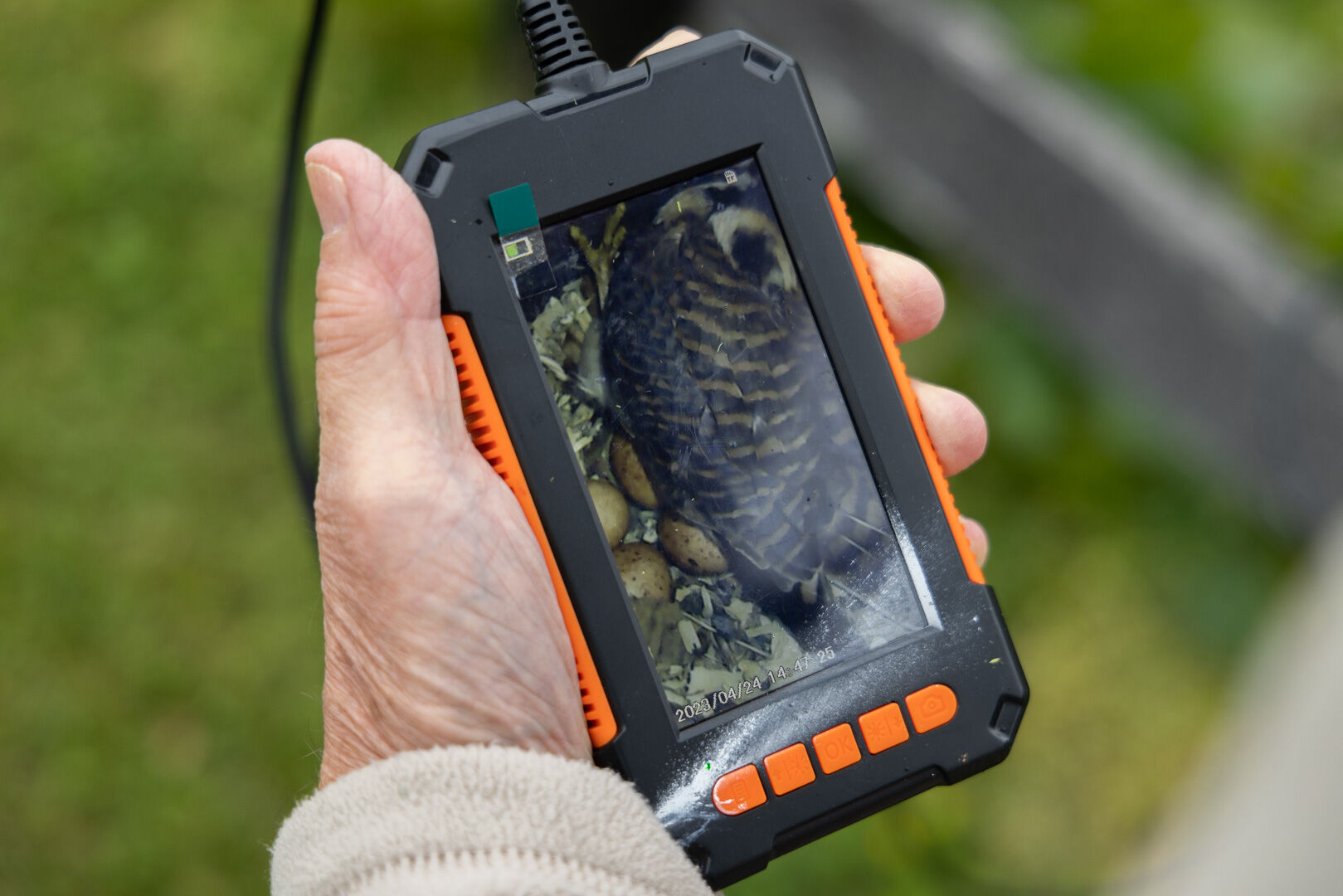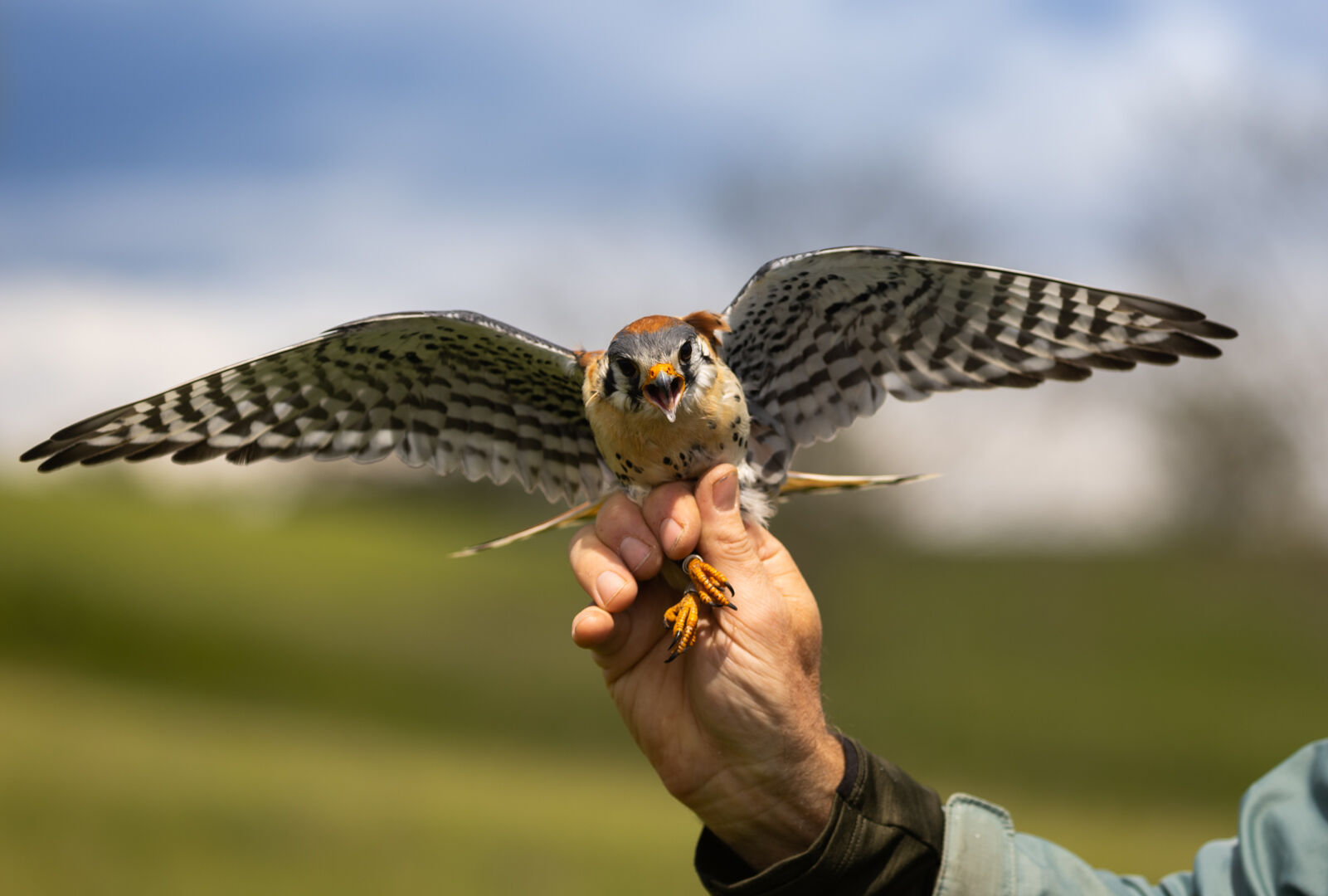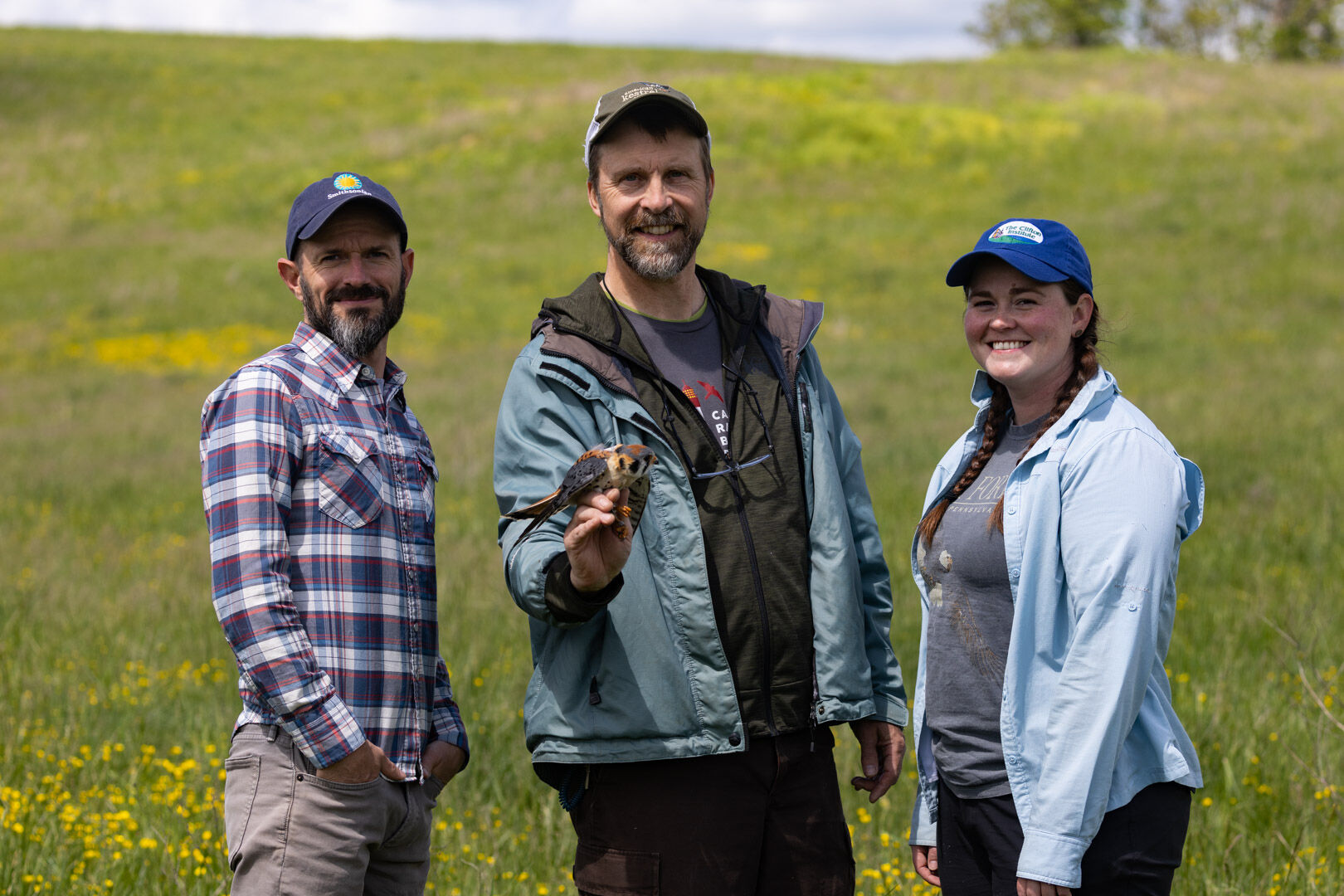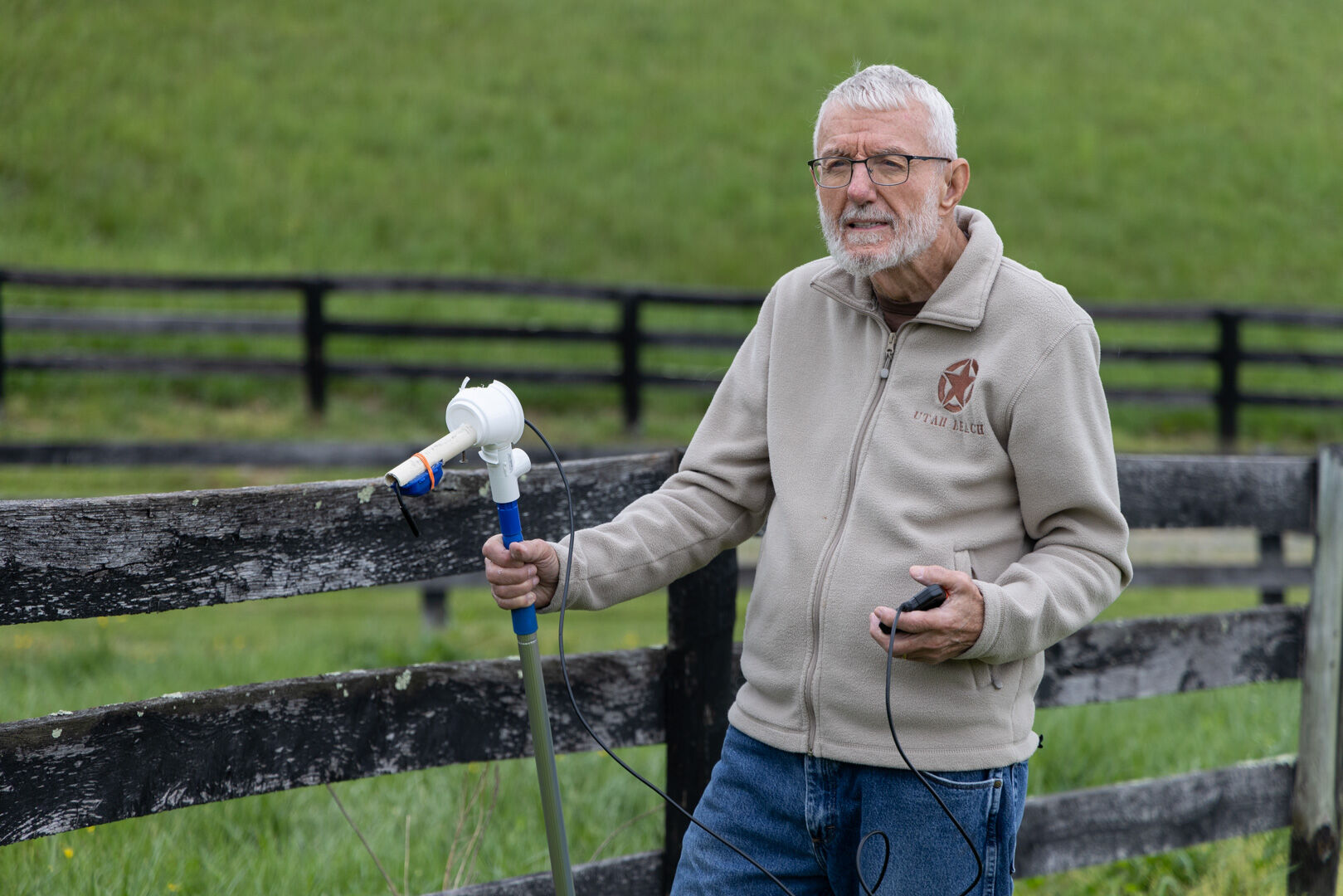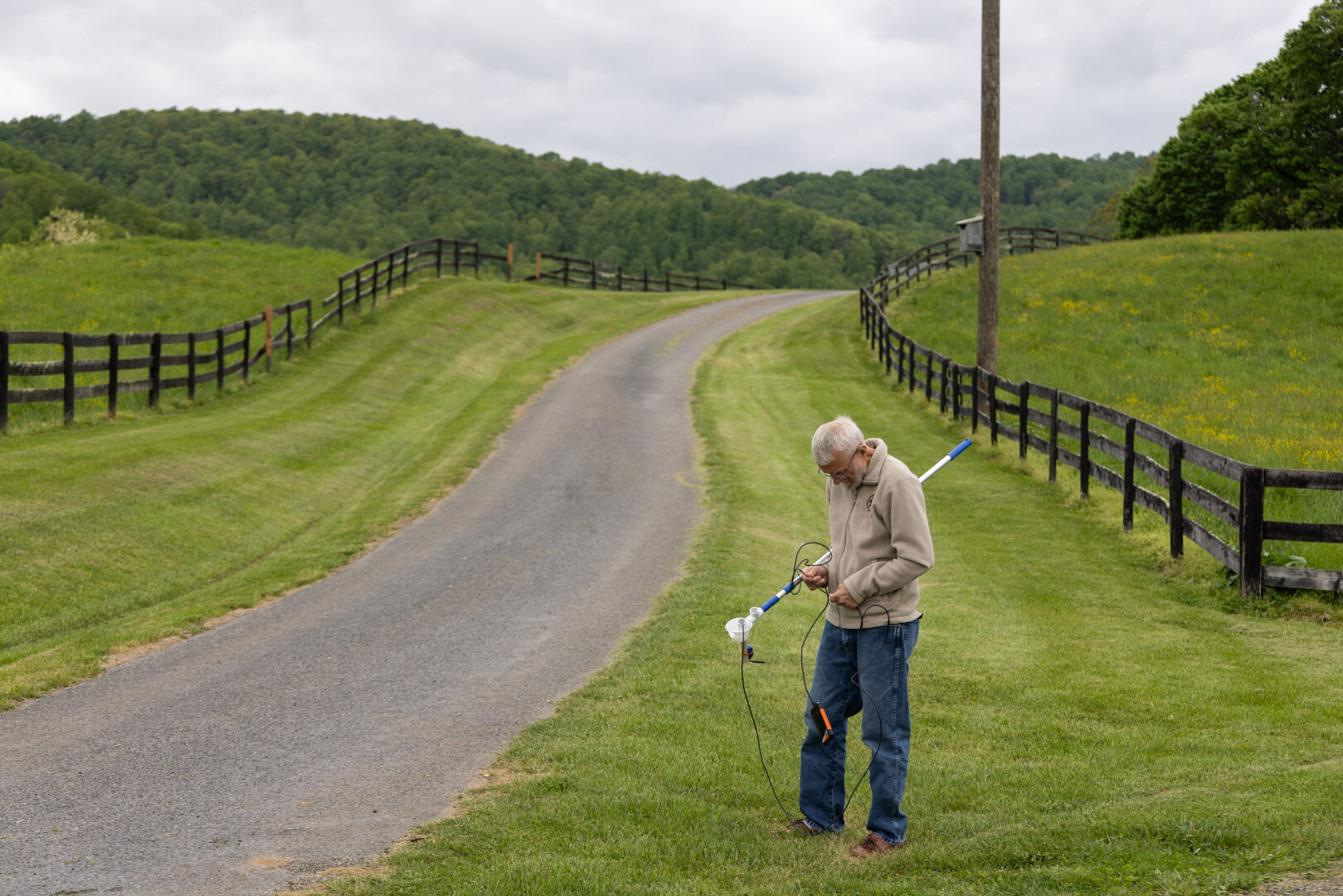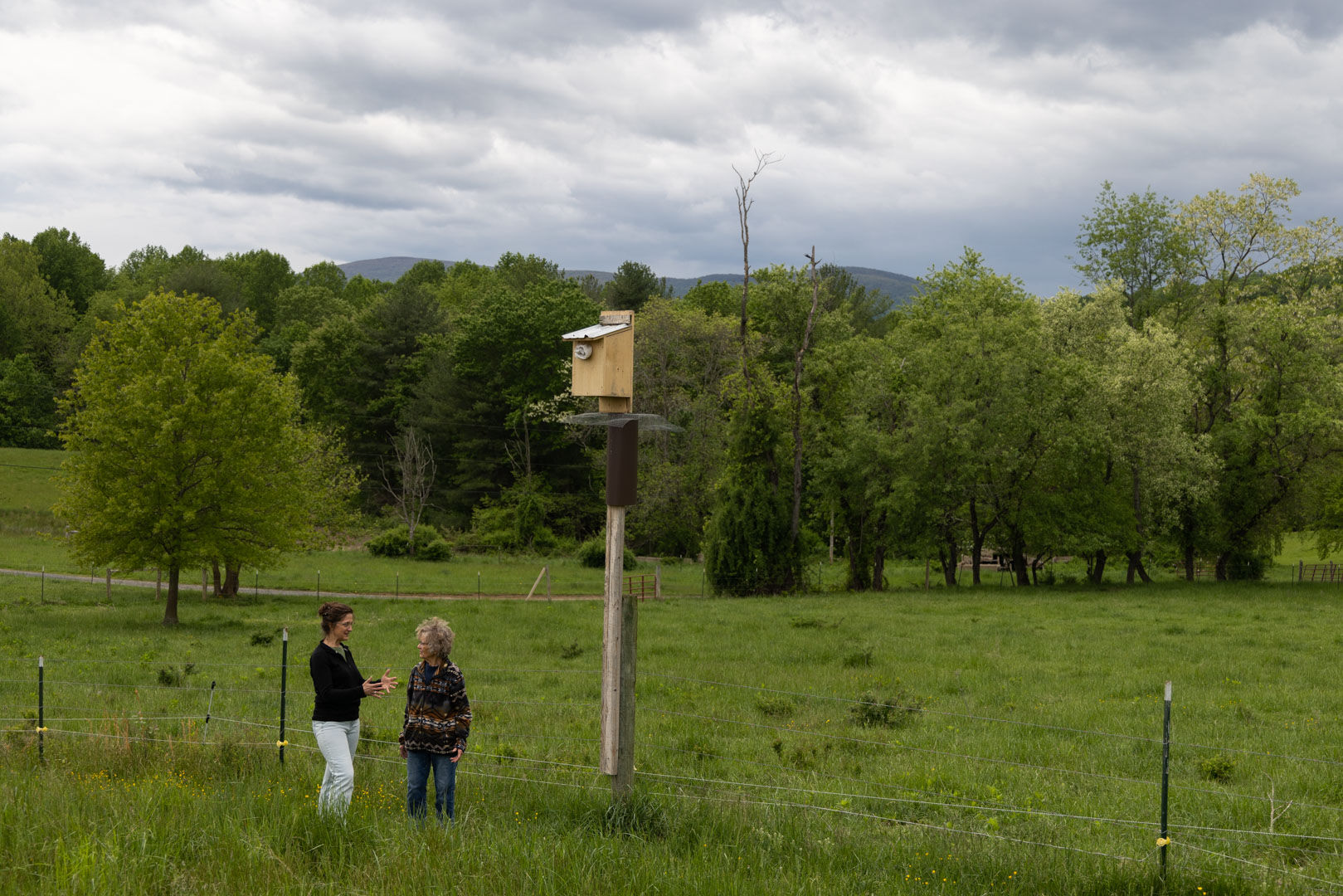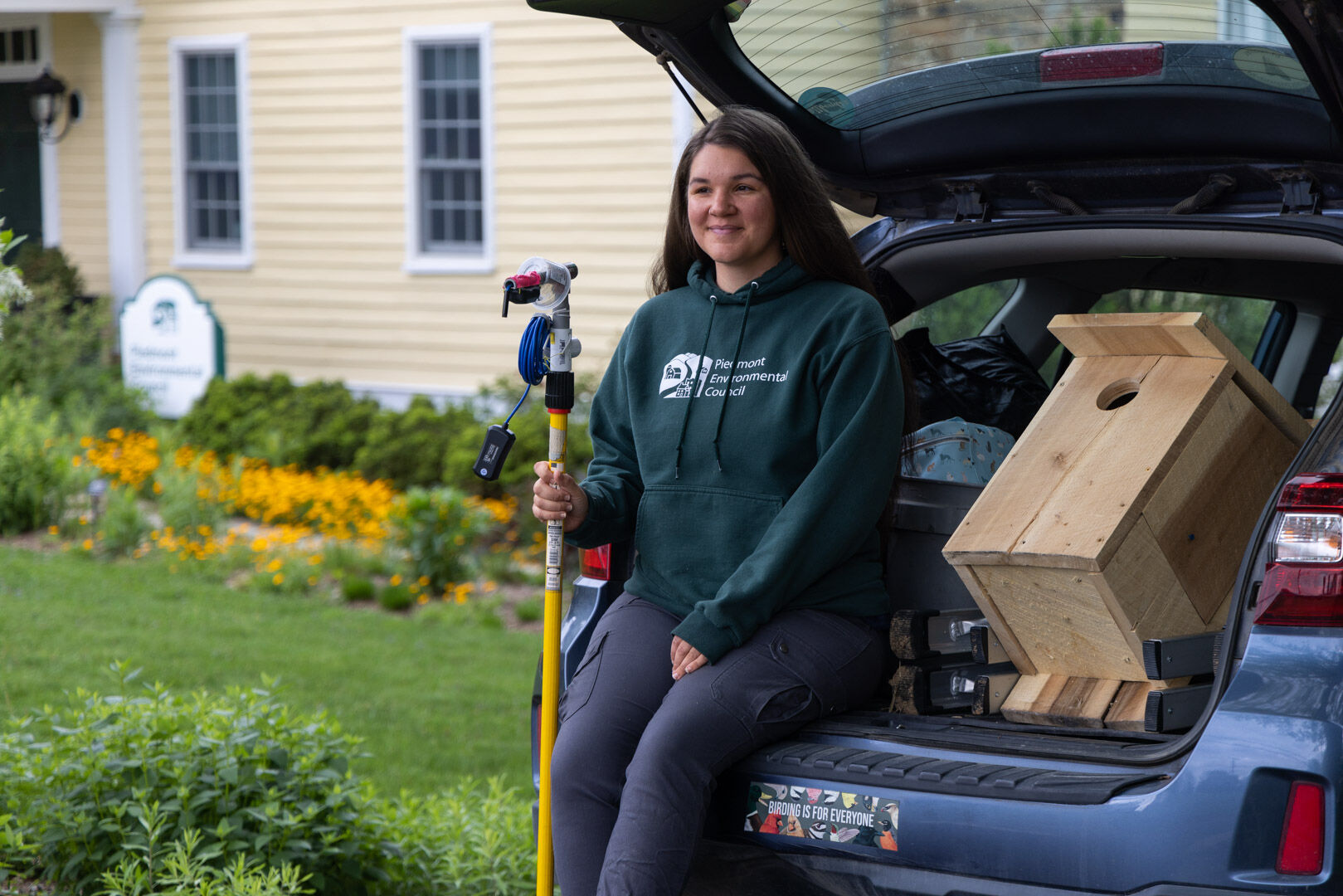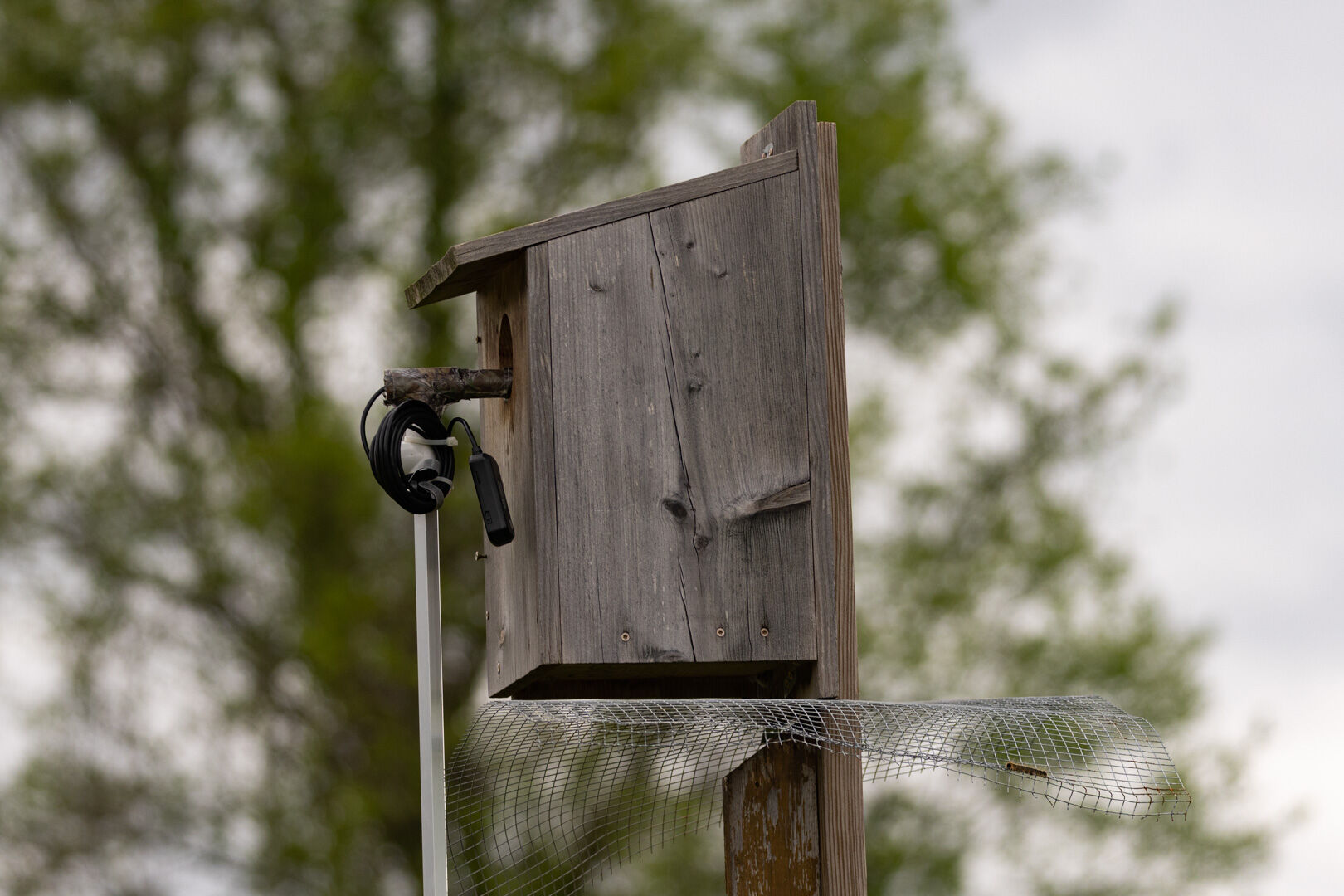The new star of Rappahannock County is the kestrel, the colorful, feisty, falcon featured in this newspaper in August last year.
The kestrel is North America’s smallest falcon. Its dwindling numbers have scientists mystified and now landowners in Rappahannock and surrounding counties are stepping up, erecting nest boxes and helping to monitor the threatened raptors in what has become a remarkable multi-organization, avian endeavor.

2023-05-FF-Kestrel-Tagging–16.jpg
“Clyde,” a kestrel that nests on Rappahannock resident Jim Manwaring’s property.
“After that article came out, our phone just started ringing,” said Justin Proctor, program coordinator for Virginia Grassland Bird Initiative. The initiative is run by the Smithsonian’s Virginia Working Landscapes (VWL), which promotes science-based land management practices to benefit grassland birds. “Within a week of publication, we got at least seven calls from people interested in putting kestrel boxes on their land – and the phone hasn’t stopped ringing,” he said.

2023-05-FF-Kestrel–67.jpg
Justin Proctor, program coordinator for Virginia Grassland Bird Initiative, monitors a box in Flint Hill.

2023-05-FF-Kestrel-B-74.jpg
A piece of mesh, termed a ‘predator guard,’ is mounted to the pole to help protect the box, mainly from snakes.
The grassland bird initiative is supported by the Piedmont Environmental Council (PEC); American Farmland Trust; and Quail Forever. And it complements ongoing kestrel research by another Smithsonian project at the National Zoo Conservation Biology Institute (NZCBI) in Front Royal, and the Clifton Institute in Warrenton. The groups work in concert to develop conservation practices on grasslands where kestrels and other birds forage and nest.
To keep up with the public demand for kestrel boxes, Proctor, and October Greenfield, PEC’s wildlife habitat coordinator, enlisted the Rappahannock County High School (RCHS) building trades program. Armed with grants from the Volgenau Foundation and the Richard Lykes Fund, Proctor and Greenfield covered the cost of 55 kestrel boxes.

2023-05-FF-Kestrel-PEC-October–3.jpg
October Greenfield of Piedmont Environmental Council loads up her car with monitoring gear.

kestrel boxes.jpg
“The students built 30 boxes last year, and 25 this semester which will be installed later this fall,” said Greenfield. “After the boxes were built, I went into the classroom and gave a talk on how their involvement was helping make positive conservation changes that can benefit kestrels. All in all, it was a wonderful way to involve students in a program that is making a positive difference for kestrels.”
Scott Schlosser, the RCHS building trades tech instructor agreed, calling the project a “win-win” for his students. “Not only did they get woodworking experience, but they learned a lot from October about the nesting and foraging habits of these beautiful raptors.”
Sign up for Rapp News Daily, a free newsletter delivered to your email inbox every morning.
In the last decade Virginia Working Landscapes got to know more than 200 landowners, 22 of them in just the last 12 months. “Over the past year the kestrel has become our number one tool in connecting with landowners. It’s a great door-opener. Talking about putting up nesting boxes often leads into broader conversations about land management practices that benefit a variety of bird life,” said Proctor. “There are now so many kestrel boxes around the area, people are taking notice and want to become involved in the program.”
According to Proctor, “a big handful” of the new boxes already are occupied. With kestrels expected to actively adopt boxes into early May, even more are likely. “First-year occupancy can sometimes be as high as 40%, which would be exciting to reach this year,” he said.
Barbara Caceres, a social worker who lives outside Flint Hill, is one of those people.
After noticing her neighbor’s kestrel box, Caceres got in touch with Proctor and had a box placed on her property. “As I learned more, our discussion turned to what we as landowners could do to further improve our fields, not just for kestrels, but other grassland birds,” she said.

2023-05-FF-Kestrel-Barbara–1.jpg
Barbara Caceres manages a kestrel box on her property north of Flint Hill. Her mother, Marilyn Zimmerman often accompanies her.

2023-05-FF-kestrel–barbara.jpg
Barbara Caceres and her mother, Marilyn Zimmerman, who often joins her on trips to the kestrel box.
Caceres quickly became a neighborhood booster for the grassland bird initiative, organizing local field outings with habitat experts. “On one of our walks last May, we had over 20 people attend. As a result, several of our neighbors delayed haying their fields until after the Fourth of July so nesting birds had a chance to get their fledglings out before cutting began.”
Gid Brown Hollow resident George Gardner is another who stepped up, offering to monitor the six boxes in his area. “The kestrel article last fall is what stimulated me to get involved,” said the retired condominium management consultant. “I have degrees in wildlife and systems ecology, and formerly worked at the Department of Interior, so this project provided a perfect opportunity for me to engage in a local wildlife conservation project.”

2023-05-FF-Kestrel-George–1.jpg
George Gardner inspects a box in Gid Brown Hollow with an endoscope that connects to a mobile device that captures an image inside the box.

2023-05-FF-kestrel-george-111.jpg
George Gardner

2023-05-FF-Kestrel-George–4.jpg
An image from George Gardner’s mobile device of a female Kestrel, however males often help with incubation procress.
Trained by research team member Alan Williams, Gardner uses a pole-mounted camera to peek into the boxes. “I check each box once a week to see if it is occupied, look for any eggs, and hopefully record hatchlings when they come. The research team and each landowner receive a weekly update on my findings. It is an exciting time of year and with luck some of the boxes will soon hold fledglings.”
The increase in nesting boxes gives researchers at NZCBI a better handle on kestrel populations, but only if they are monitored regularly.
“Having all these new boxes going up can be a big help with our research project,” said Joe Kolowski, a research scientist and training manager at NZCBI. “It is great if kestrels use the boxes, but from a research standpoint those boxes need to be monitored so we can generate data to understand kestrel declines. This year we are undertaking a pilot program to recruit volunteers and landowners to keep track of box activity.”

2023-05-FF-kestrel-tagging-B-299.jpg
Tagging Research team member Joe Kolowski (left), who co-founded the project under the umbrella of the Smithsonian Conservation Biology Institute, just outside of Front Royal, Alan Williams, with Megan Lemmo a kestrel capture technician for Clifton Institute, tag and install a transmitter backpack on a male kestrel on a property near Five Forks. Property owners are given naming rights, Jim Manwaring decided on ‘Clyde.’ Its partner will be named Bonnie.

2023-05-FF-Kestrel-Tagging–1.jpg
An assortment of transmitters, they are solar powered, remotely programmable and quite durable, normally lasting two years.

2023-05-FF-Kestrel-Tagging–2.jpg
Kestrels are remarkably docile during the tagging and transmitter installation, which takes 30 – 40 minutes. A leather hood helps relax the bird of prey by removing visual stimuli.

2023-05-FF-Kestrel-Tagging–14.jpg
Each transmitter backpack is secured with square knots, with tied ends reinforced with dental floss and finally coated with epoxy. This prevents the birds from undoing the knots with their beaks.

2023-05-FF-Kestrel-Tagging–11.jpg
“Clyde,” a kestrel that nests on Rappahannock resident Jim Manwaring’s property.

2023-05-FF-kestrel-tagging-393.jpg
Alan Williams placing the kestrel back in its box after being tagged and outfitted with a transmitter ‘backpack.’
For the past two years Kolowski has been tracking a handful of kestrels outfitted with mini-GPS transmitter “backpacks.” This spring, he, Burt Harris, co-executive director of the Clifton Institute, Williams, and a group of interns are putting transmitters on another 40 kestrels. “The transmitters, combined with data from the nesting boxes, will give us a very good picture about the habits of kestrels, where they hunt, how they use the landscape, and how far they migrate.”

2023-05-FF-Kestrel-Tagging–5.jpg
Joe Kolowski uses a radio antenna to receive data from the transmitter, seen above, which is ingested to software and then analyzed. Currently, they are monitoring nearly 30 adult kestrels in the region.The tracking data allows the team to investigate the patterns of local movement, selection of farm habitats, migration routes, and ultimately insight into their declining numbers.

2023-05-FF-Kestrel-Joe-1-2.jpg
Joe Kolowski, who co-founded the project under the umbrella of the Smithsonian Conservation Biology Institute, just outside of Front Royal, Va.
The groundbreaking program enables researchers to track kestrels with pinpoint accuracy. One kestrel, named “Peaches,” migrated hundreds of miles, from its nesting area at the Clifton Institute to a farm in Georgia, where it spent the winter. The following spring it returned to its nest box at the institute. “If you are trying to assess the risk factors to kestrels, like habitat loss, you need to know where they are spending the entire year,” said Kolowski.

kestrel-peaches-InstaLayoutWinter2022-23.jpg
“Peeaches” travels
Local interest in kestrels was sparked largely by now deceased Rappahannock County resident, Roger Jones, who started putting kestrel boxes all around the county about 25 years ago.
“He worked with local conservationists who had an interest in kestrels, and that eventually led to the nest box program now underway,” said his brother, Bruce, who with his wife Susan, maintains a large nature preserve off Long Mountain Road, near the Town of Washington. “I’m sure Roger is looking down from somewhere and smiling at all these people taking care of kestrels,” he said.
When it comes to environmental protection, Caceres, who grew up in a rural community, believes simple actions by individuals make a difference.
“There is so much discussion about environmental degradation, species loss, and climate change that one feels little ability to bring about change,” she said. “But doing something like putting up a kestrel box is a positive action that mitigates the feeling of helplessness. If each of us did what we could in our own backyards, I’d like to think collectively we could make a difference.”
By Bob Hurley for Foothills Forum
To learn more about the kestrel program or grassland conservation contact Justin Proctor of VWL at [email protected], or October Greenfield of PEC at [email protected].

Foothills logo – horizontal
Foothills Forum is an independent, community-supported nonprofit tackling the need for in-depth research and reporting on Rappahannock County issues.
The group has an agreement with Rappahannock Media, owner of the Rappahannock News, to present this series and other award-winning reporting projects. More at foothillsforum.org.


